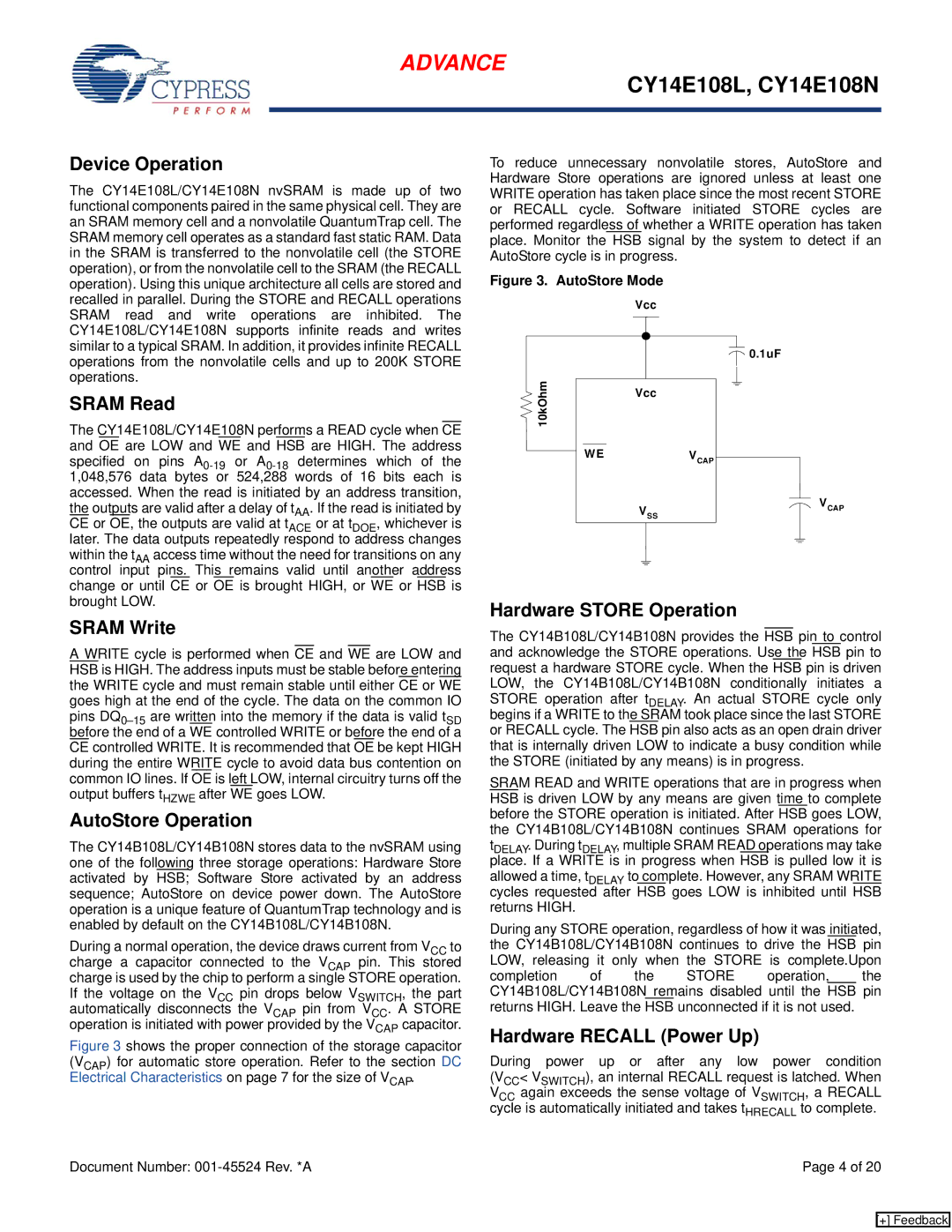Device Operation
The CY14E108L/CY14E108N nvSRAM is made up of two functional components paired in the same physical cell. They are an SRAM memory cell and a nonvolatile QuantumTrap cell. The SRAM memory cell operates as a standard fast static RAM. Data in the SRAM is transferred to the nonvolatile cell (the STORE operation), or from the nonvolatile cell to the SRAM (the RECALL operation). Using this unique architecture all cells are stored and recalled in parallel. During the STORE and RECALL operations SRAM read and write operations are inhibited. The CY14E108L/CY14E108N supports infinite reads and writes similar to a typical SRAM. In addition, it provides infinite RECALL operations from the nonvolatile cells and up to 200K STORE operations.
SRAM Read
The CY14E108L/CY14E108N performs a READ cycle when CE and OE are LOW and WE and HSB are HIGH. The address specified on pins A0-19or A0-18determines which of the 1,048,576 data bytes or 524,288 words of 16 bits each is accessed. When the read is initiated by an address transition, the outputs are valid after a delay of tAA. If the read is initiated by CE or OE, the outputs are valid at tACE or at tDOE, whichever is later. The data outputs repeatedly respond to address changes within the tAA access time without the need for transitions on any control input pins. This remains valid until another address change or until CE or OE is brought HIGH, or WE or HSB is brought LOW.
SRAM Write
A WRITE cycle is performed when CE and WE are LOW and HSB is HIGH. The address inputs must be stable before entering the WRITE cycle and must remain stable until either CE or WE goes high at the end of the cycle. The data on the common IO pins DQ0–15are written into the memory if the data is valid tSD before the end of a WE controlled WRITE or before the end of a CE controlled WRITE. It is recommended that OE be kept HIGH during the entire WRITE cycle to avoid data bus contention on common IO lines. If OE is left LOW, internal circuitry turns off the output buffers tHZWE after WE goes LOW.
AutoStore Operation
The CY14B108L/CY14B108N stores data to the nvSRAM using one of the following three storage operations: Hardware Store activated by HSB; Software Store activated by an address sequence; AutoStore on device power down. The AutoStore operation is a unique feature of QuantumTrap technology and is enabled by default on the CY14B108L/CY14B108N.
During a normal operation, the device draws current from VCC to charge a capacitor connected to the VCAP pin. This stored charge is used by the chip to perform a single STORE operation. If the voltage on the VCC pin drops below VSWITCH, the part automatically disconnects the VCAP pin from VCC. A STORE operation is initiated with power provided by the VCAP capacitor.
Figure 3 shows the proper connection of the storage capacitor (VCAP) for automatic store operation. Refer to the section DC Electrical Characteristics on page 7 for the size of VCAP.
To reduce unnecessary nonvolatile stores, AutoStore and Hardware Store operations are ignored unless at least one WRITE operation has taken place since the most recent STORE or RECALL cycle. Software initiated STORE cycles are performed regardless of whether a WRITE operation has taken place. Monitor the HSB signal by the system to detect if an AutoStore cycle is in progress.
Figure 3. AutoStore Mode
| | Vcc |
| 10kOhm | 0.1uF |
| Vcc |
| |
| WE | VCAP |
| | VCAP |
| | VSS |
Hardware STORE Operation
The CY14B108L/CY14B108N provides the HSB pin to control and acknowledge the STORE operations. Use the HSB pin to request a hardware STORE cycle. When the HSB pin is driven LOW, the CY14B108L/CY14B108N conditionally initiates a STORE operation after tDELAY. An actual STORE cycle only begins if a WRITE to the SRAM took place since the last STORE or RECALL cycle. The HSB pin also acts as an open drain driver that is internally driven LOW to indicate a busy condition while the STORE (initiated by any means) is in progress.
SRAM READ and WRITE operations that are in progress when HSB is driven LOW by any means are given time to complete before the STORE operation is initiated. After HSB goes LOW, the CY14B108L/CY14B108N continues SRAM operations for tDELAY. During tDELAY, multiple SRAM READ operations may take place. If a WRITE is in progress when HSB is pulled low it is allowed a time, tDELAY to complete. However, any SRAM WRITE cycles requested after HSB goes LOW is inhibited until HSB returns HIGH.
During any STORE operation, regardless of how it was initiated, the CY14B108L/CY14B108N continues to drive the HSB pin LOW, releasing it only when the STORE is complete.Upon
completion of the STORE operation, the CY14B108L/CY14B108N remains disabled until the HSB pin returns HIGH. Leave the HSB unconnected if it is not used.
Hardware RECALL (Power Up)
During power up or after any low power condition (VCC< VSWITCH), an internal RECALL request is latched. When VCC again exceeds the sense voltage of VSWITCH, a RECALL cycle is automatically initiated and takes tHRECALL to complete.

